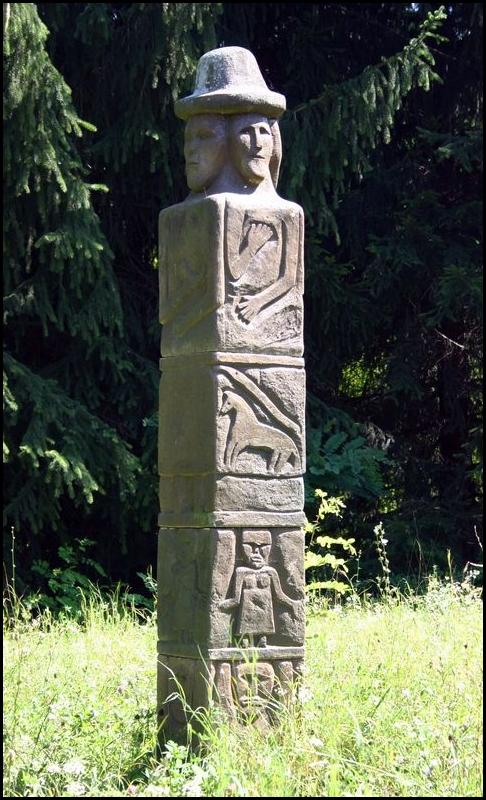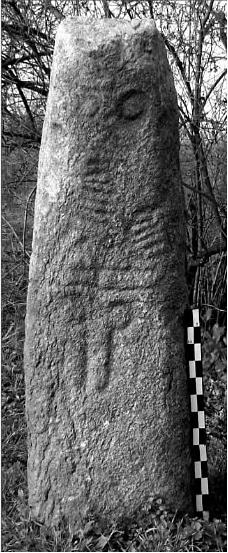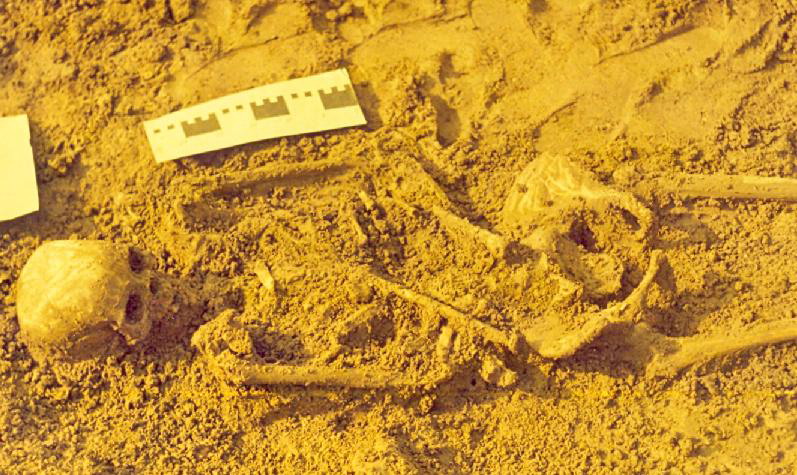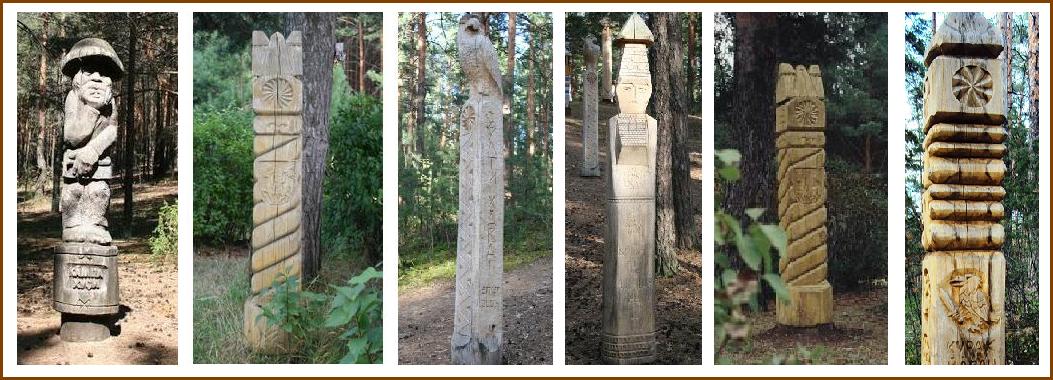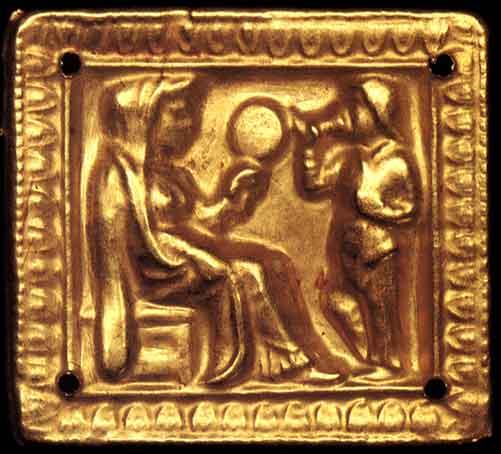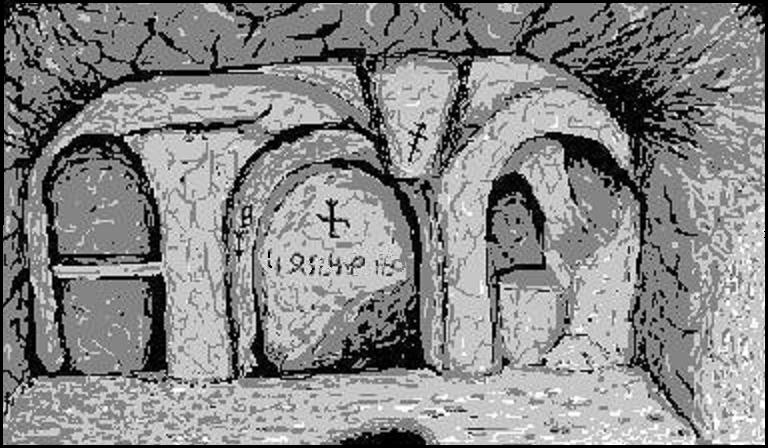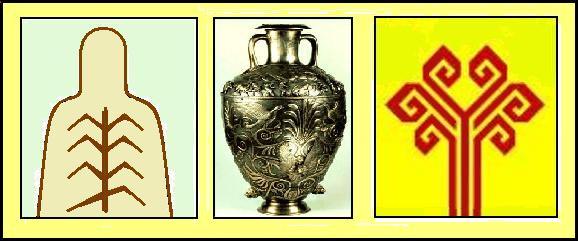

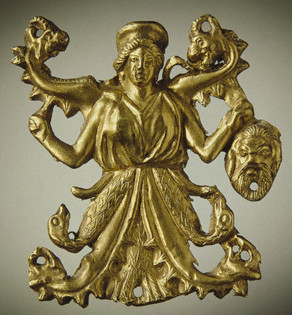
Scythian Mythology
There is extensive literature devoted to the Scythian mythologyin the world, but most researchers initially wrongly refer the Scythians to the Iranian people, and then selectively adapt more or less pertinent facts to explain meaning of the names of gods, myths, and legends or scenes depicted on the Scythian vases and so on. Such activities are hard to be called the science, it is sophistry in the spirit of Aristotle, if left unattended professional analysis of objects of material culture by archaeologists. A certain exceptions in this choir was the work of a bona fide Russian scientist, who although defended the Iranian ethnicity of the Scythians, but still payed attention to the inconsistency of some facts to such canon (ROSTOVTSEV M.I. 2002.)
Many linguistic and archaeological evidence convince us that the Scythians were the Turkic Bulgars. The same is confirmed also by the Scythian mythology. Identifying ancient Bulgars with the Scythians, we get a satisfactory explanation for the significant fact of absence of fire, wheel, and chariot in the Scythians worship, so characteristic for the Iranian people. And at the same time the Scythian mythology has acceptable explanation for deciphering the names of Scythian gods by means of the Chuvash language. Scythian monuments of culture have a certain reflection in the Chuvash beliefs and customs, although some of them are considered not as Scythian ones, such as the mysterious stone Zbruch idol (see the photo at left).
The totem pole found in the Zbruch River, the left tributary of the Dniester, in 1848, was traditionally considered as a Slavic monument, however some scientists believe it has no analogies in Slavic mythology and reveals a great similarity with Scythian stone sculptures. This case gives grounds to look for clues of this carved image in Scythian mythology.
According to Herodotus, the Scythian cult did not know the images of the gods, but M. Rostovtsev seen in his words a contradiction with the facts, noted the presence of the image of the Scythian gods, which were made for the Scythians by the Greeks. However, ignoring anthropomorphic stone sculptures in the steppes, he gave an explanation of this fact as they allegedly were a result of hellenization of the Iranian population in steppes at a later period (ROSTOVTSEV M.I. 2002: 55) .
D. Rajewski argues that human images were borrowed by the Scythians from ancient oriental and Ionian traditions, examines the evolution of sculptures and comes to the conclusion that they reflect the way of modeling the universe, pointing out that some researchers give them mythological interpretation (RAYEVSKIY D. 2006: 246-254)/
At right: Steppe stone sculprure. The park-museum of stone "babas" (Luhansk, the city on eastern Ukraine).
In 2011, a granite pillar was found in the village of Ruchaivka in Zaporozhye region. As it turned out after investigation this is a Scythian anthropomorphic stele (see. photo below).
Left: Stella from Ruchaivka, front side
. Photo from the magazine "Archeologia" (OSTAPENKO M.A., PANCHENKO I.V. 2014. 2014, 61. Fig. 2)
According to the description of the figures, it refers to a variety of anthropomorphic pillars. The figure represented a man has two circles, obviously protective plates on the breast. The man holds a massive rhyton in his right hand. One clearly seen a belt with buckle-clasp, on which hang an acinaces and a quiver. Hands of the man are bent at the elbows, and, as it usually happens in such figures and in the tombs, right hand is pressed to his chest, and the left does to the stomach (compare with Zbruch idol and the photo below). Enigmatig meaning of the hand position does not yet have an explanation, but it is practiced in the graves for thousands of years.
In 1992, an expedition of the Association of Leo (Lviv) excavated under the direction of Ph.D. V.S. Artyukh a human burial with the same hand positionon on a Trypillian site near the village of Moshanets of Kelmentsi district in Chernivtsi Region. Obviously this ritual was adopted by the Scythians-Bulgars fron the Trypillians, even when they lived in close proximity. Ukrainian archaeologists, describing in detail the sculpture of Ruchaivka, made the following generalization:
It seems that in the archaic time these monuments bacame dominant symbolism of the "world tree" or the phallus, which on anthropomorphic traits appear. Later, they become more and more humanoid form with a gradual transition to the anatomic sculptural plasticity and, possibly, to personalization of an image (ibid, 63).
The human burial from the Trypillian site near the village of Moshanets
. Photo of Valentyn Stetsyuk.
However, first let us start ab obo and consider Herodotus' legend about the origin of the Scythians. According to this legend, the first man in the once desolate country was Targitaios (Ταργιτάον), the son of Zeus and the daughter of the river Borysthenes (HERODOTUS, 1993: IV, 5). The first partial word of the name has such correspondences in the Turkic languages: Old Turkic täŋri 1. "heaven", 2. "god", Balk., Karach. tejri, Tur. tanri, Chuv. tură, Yakut. taŋara etc "god". Having taken into consideration Old Turkic toj"feast", Balk., Karach. toj, Tat., Chuv. tuj "wedding" the name Targitaios can be explained as "the wedding of gods”. This wedding can be referred to the known in mythology category of "the sacred marriages" of old ancestors (LEVINTON G.A. 1991, MFW, Volume 2: 422-423). Targitaios had three sons: Lipoxaïs (Λιπόξαϊν), Arpoxaïs (Ἀρπόξαϊν) and Colaxaïs (Κολάξαιν). V. Abayev, which is considered to be a graet authority in Scythian question, asserted that the second part of these names is -ksay and explained it as "a king-ruler" (Av *xayaš "to shine"). Thefore he gave for Colaksay such etymology: *Xola-xayaša"Sun-king" (ABAYEV V.I. 1965: 35). The first part of the restored name is questionable in the absence of Iran *xola though words xor/xur "a sun" are present in some Iranian languages. However V. Abaev considered the transition r → l untypical for the Iranian languages and searched for its explanations (Ibid: 36) but later in another paper nevertheless acknowledged that "the first part is not clear" (ABAYEV V. I., 1979: 310). A.K. Shaposhnikov asserts that this name is not Indo-Iranian (Шапошников А.К., 2005, 41). Other two names have been usually explained without details as Mountain-king and Depth-king that allows seeing the connection of all names with the elements of the universe as the Upper, Middle and Lower Worlds (DUDKO D.M., 1988: 66).
Another interpretation of all three names can be given by means of the Chuvash language. First of all, Turk. arpa "barley" (Chuv. urpa) attracts attention, further, the typically Turkic say which, as well as ksay, can be the second part of all three names. In that case, these names can be divided into such two parts: Arpak-say, Colak-say and Lipok-say. Chuv. săy "dish, course" together with arpa suits to the explanation of Targitaios' name as no wedding goes without a banquet. Thus, Arpaxais means "the dish of barley”. The epenthentic sound k appeared in this word obviously due the similarity to two other names and for comfortable articulation.
According to the sense of the word arpa, kolak, and lipok also should mean such subjects which can be some food. Chuv. kayăk "bird" instead of kolak can be taken according to the sense as Chuv. a can correspond old Turc. o, and Chuv. ă does old Turk. a(RONA-TAS A. -1, 1987-1: 47). The only objection can be caused by the discrepancy l → y. Old Turk. l was kept in the Chuvash language therefore this transition is not natural here but in principle it often takes place in other languages. On the other hand, there is semantically close Chuv. kălăk "brood-hen", which increases the likelihood of explanation of Colaxais as "dish of bird". As for the name Lipoxais, probably, it is a little deformed by Herodotus or by his informant. Mayby, Lipoxais should sound as Paliksais then the first part of the name would good correspond to Turk. balyk "fish" (modern-day Chuv. pulă). Hence, to the wedding of gods, three dishes have been sent – the course of bird, barley, and fish. The first dish could correspond to Scythian imaginations about "Upper World", the second dish would be referred to "Middle World", and the third one does to "Low World". Such personification of the elements of the universe corresponds better to the idea because understanding of mountain as "the middle world" must be accepted only by the big effort. The mountain approaches to the concept of "Upper World" more likely.
Trinomial model of the universe was adopted by the Bulgars from Trypillians who divides the world into an underground, ground and celestial sphere. This is evidenced by ornamental compositions on Tripoli culture monuments, going in times of Chalcolithic [ZALIZNIAK L.L. (Ed). 2005, 125]. According Chuvash folk cosmogony the world is also imaged in the form of three storeys above ground, and the Earth is a square. This representation generally corresponds to the Zbruch idol, which with we began talking. And, as it turns out, Chuvash till now represent ancient beliefs in the form of totem poles. The album with pictures of sculptures of ethno-cultural park "Suvar" in the city of Cheboksary (Chuvashia) clearly demonstrates this. Among the several dozen wooden figures, we can find some of them having resemblance to the Zbruch idol (see photos above). Note the typical position of the hands of the left figure. But in general, we have reason to assume that the erection of the Chuvash totem poles in ancient times had the same purpose as the anthropomorphic sculptures of the Scythians, which were "one of a objective embodiments of the cosmic pillar as the imagination of the world order" (RAYEVSKIY D. 2006: 251).
At left: Goddess Tabiti with a mirror in her hand . Gold plaque from Chertomlyk mound.
Using the Chuvash vocabulary, we can explain the names of all Scythian gods mentioned by Herodotus. The most worshipped goddess at the Scythians was Tabiti, who corresponds to chaste Greek Hestia, the goddess of a home. On this occasion, M. Rostovtsev said:
At first glance it seems strange to find in the Iranian pateone a goddess with non-Iranian name Tabithi occupying in it the highest place, while the supreme god takes only the second place (ROSTOVTZEFF M. 1922, 107).
M. Rostovtsev gave his elucidation of this fact, which apparently did not satisfy V. Abaev. Looking for parallels between the Scythian and Ossetian mythology, Abaev found a match for Hestia and Tabiti in the Ossetian deity of hearth and a chain. His making the chain presented to the people is especially accentuated (A. ABAYEV V.I. 1979, 10).
As you can see, the similarities of male deity and goddesses Tabiti is very far and even Safa's name has no interpretation in the Ossetian language. On the contrary, Tabiti's name emphasizes her chastity, because it can be explained as "who has given the vow of chastity", according to Chuv. tupa tu "to give an oath". Till now the Chuvash have the custom, "tupa tu" (to give the oath of allegiance during the marriage).
Dmitry Rajewski treats Herodotus' words about specially sacred oaths of the Scythians (τάς βασιλτηίας ίστίαζ) as oats for "Royal Hestias", that is as the oats for Tabiti (RAYEVSKIY D. 2006, 65). He also explains the mirror in the hand of the goddes by the existence of a wedding ritual and other ceremonies related to marriage, in which a mirror is present as an essential attribute of a traditional (ibid. 73). As you can see, the modern Chuvash tradition is directly linked to the custom of the Scythians.
At right: The interior of a Bulgar cave sanctuary on the Dniester River near the village of Stinka The sketch of the Valentyn Stetsyuk. 1989.
Inscription "tupa tu" is present on the altar of the Bulgarish cave temple on the bank of the Dniester River
Greek Zeus and Gaia, by Herodotus, had Scythian matches Papaios and Api whose names can be understood as "Grandfather" and "Grandmother", h.e. "Primogenitors", according to Chuv. papay "a grandfather" and Chuv. epi "a midwife". The functions of Greek god Apollo were various but he acted as an arrow-shooter or a destroyer most frequently (LOSEV A.F., 1991. MFW, Volume 1: 92-95). He is connected by Herodotus with Oitosyros of Scythian mythology, whose name could be understood as "who calls down trouble” (Chuv. ayta "to call" and šar"trouble"). The name of Scythian goddess Argimpasa, which was corresponded the Greek goddess of fertility Aphrodite, is possible to explain by means of Chuv. arăm "a wife" orărăm "swear" and pusă "field". By the certain presumption, it is possible to explain also the name of Scythian god Thagimasadas which corresponds to Greek Poseidon, the god of seas and all water elements. In due time Poseidon, trying to ruin Odyssey, has broken his raft therefore Chuv. takana "a trough" (might to be before "a boat" too) and šăt "to hole" can have interest in this case.
And, at last, we shall talk about legendary Amazons. This name (from Gr. Αμαζων) is known us from Herodotus and means aggressive horsewomen.
According to the ancient Greek national etymology, it was cleared as α-μαζωσ"breastless" (μαζωσ Gr poetically "breast") as amazons, according some Greek myth, had cut off the right breast themselves for better to shoot with a bow. The explanation is interesting but it doesn’t satisfy scientists.
Left: Hercules comes in fight with an Amazon. (Metropolitan Museum of Art, Нью-Йорк, США)
Another explanation could be given by means of Chuvash vocabulary. This mysterious name could have something similar to Chuv. çyn "a person, man". Taking into account Chuv. amă “a female, mother”, we find the explanation to the word the amazon – “the mother of people”. Herodotus explained the origin of Sauromatians from the marriage of the Amazons with Scythians and wrote:
…now the Amazons are called by the Scythians Oiorpata, which name means in the Hellenic tongue "slayers of men," for "a man" they call oior, and pata means "to slay"… (HERODOTUS, 1993: IV, 110-116).
Thus, Herodotus precisely specifies two Scythian words oyor and pata and gives their meaning. In modern Chuvash language ăyăr means "stallion", and patak does "a stick". The first word could mean as well "a male", also therefore and "a man". The second word can be a derivative from not fixed Chuv. pata "to beat, kill". Mr. Fatih Şengül (Turkey) informed me that er, eyr or uri means “man, husband” and pata means “to kill, to hit” in Turkic.
Herodotus wrote that Scythians avoided borrowing customs of other folks including Hellenes, however studying the beliefs of the Scythians, absolutized Greek pantheon of gods and tried to look for some matching to them at the Scythians. He could not pay attention to some of the Scythian beliefs, considering them "barbaric". However, the worship of the Tree of Life, which survived at Chuvash until now, has its roots in the Scythian times and even in more ancient:
… original image of "tree of life"… cab be found on plates of stone boxes or slabs overlapping graves, as well as on poles of burials of Pit (Yamna) culture (АLEKSEYEVA I.L. 1991: 22)
Symbol of the Tree of Life is the main element of the state symbols of the Chuvash – the emblem and flag. Its form with branches hanging down like the form of the Tree of Life on the amphora of Chortomlyk Scythian burial mound. However, a stylized Tree of Life is also present on the pottery of Chornolis culture which from Scythian culrure was developed (see the section "Genesis of Scythian Culture"):
Among ornamented lugs (of Chornolis cups – VS), the most earliest ones are decorated with motifs of the tree (KRUSHELNYTS'KA L.I. 1998, 165).
Left: Ornamentation of a cup lug of Chornolis culture (KRUSHELNYTS'KA L.I.. 1998, 158, Fig. 95, 30).
In center: The Scythian amphora from Chortomlyk burial mound. The Tree of Life on the vase is central.
Right: The shape of the tree of life in the Chuvash emblem and flag.
Larissa Krushelnits'ka believes that these motives tend to be a type of late Komariv culture (Ibid, 156). Continuity of Komariv (15-12 century BC.), Vysotska (11 – 7 century BC.), and Chornolis cultures she stressed repeatedly in his writings.
From the above it can be concluded that the Scythian mythology is better to be deciphered by means of the Chuvash language and traditions. One can only wonder conservatism of the human mind, when time and again we find statements that the Scythians were the ancestors of modern-day Ossetians. Indeed, inscrutable Thy ways, O Lord.
